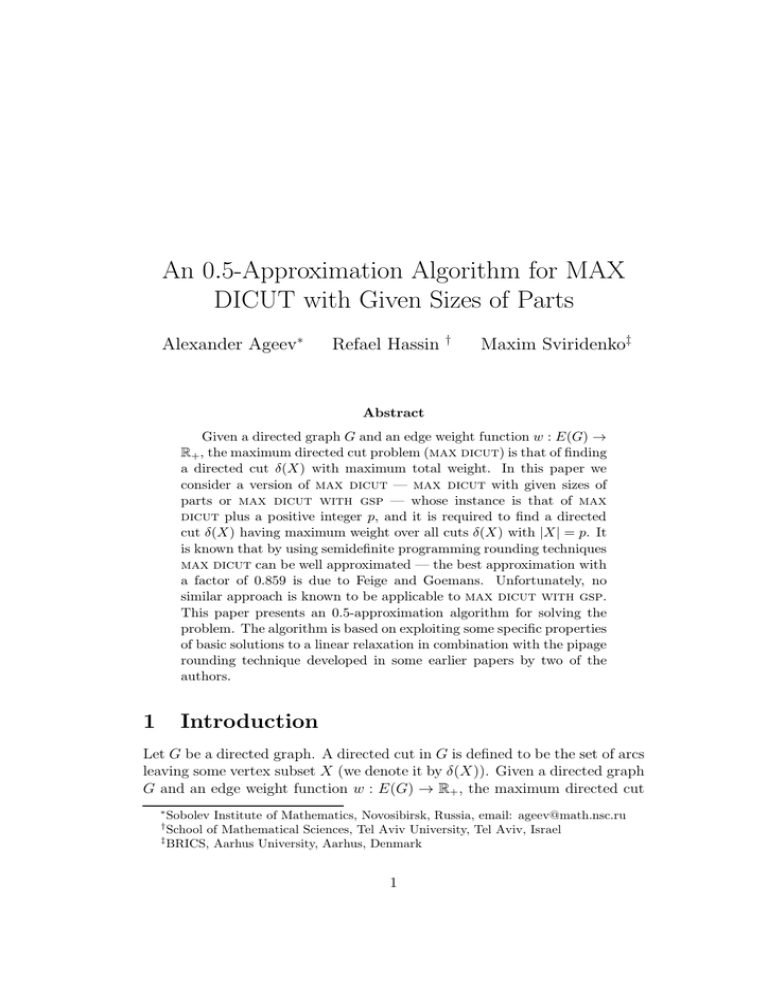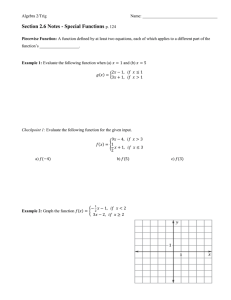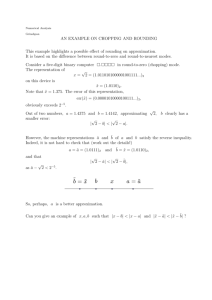.5-Approximation Algorithm for MAX An 0 DICUT with Given Sizes of Parts
advertisement

An 0.5-Approximation Algorithm for MAX
DICUT with Given Sizes of Parts
Alexander Ageev∗
Refael Hassin
†
Maxim Sviridenko‡
Abstract
Given a directed graph G and an edge weight function w : E(G) →
R+ , the maximum directed cut problem (max dicut) is that of finding
a directed cut δ(X) with maximum total weight. In this paper we
consider a version of max dicut — max dicut with given sizes of
parts or max dicut with gsp — whose instance is that of max
dicut plus a positive integer p, and it is required to find a directed
cut δ(X) having maximum weight over all cuts δ(X) with |X| = p. It
is known that by using semidefinite programming rounding techniques
max dicut can be well approximated — the best approximation with
a factor of 0.859 is due to Feige and Goemans. Unfortunately, no
similar approach is known to be applicable to max dicut with gsp.
This paper presents an 0.5-approximation algorithm for solving the
problem. The algorithm is based on exploiting some specific properties
of basic solutions to a linear relaxation in combination with the pipage
rounding technique developed in some earlier papers by two of the
authors.
1
Introduction
Let G be a directed graph. A directed cut in G is defined to be the set of arcs
leaving some vertex subset X (we denote it by δ(X)). Given a directed graph
G and an edge weight function w : E(G) → R+ , the maximum directed cut
∗
Sobolev Institute of Mathematics, Novosibirsk, Russia, email: ageev@math.nsc.ru
School of Mathematical Sciences, Tel Aviv University, Tel Aviv, Israel
‡
BRICS, Aarhus University, Aarhus, Denmark
†
1
problem (max dicut) is that of finding a directed cut δ(X) with maximum
total weight. In this paper we consider a version of max dicut (max dicut
with given sizes of parts or max dicut with gsp) whose instance is that of
max dicut plus a positive integer p, and it is required to find a directed cut
δ(X) having maximum weight over all cuts δ(X) with |X| = p. max dicut
is well-known to be NP-hard and so is max dicut with gsp as the former
evidently reduces to the latter.
The NP-hardness of max dicut follows from the observation that the
well-known undirected version of max dicut — the maximum cut problem
(max cut), which is on the original Karp’s list of NP-complete problems —
reduces to max dicut by substituting each edge for two oppositely oriented
arcs. This means that for both problems there is no choice but to develop
approximation algorithms. Nevertheless, this task turned out to be highly
nontrivial, as for a long time it was an open problem whether it is possible to
design approximations with factors better than trivial 1/2 for max cut and
1/4 for max dicut. Only quite recently, using a novel technique of rounding
semidefinite relaxations Goemans and Williamson [5] worked out algorithms
solving max cut and max dicut approximately within factors of 0.878 and
0.796 respectively. A bit later Feige and Goemans [3] developed an algorithm
for max dicut with a better approximation ratio of 0.859. Quite recently,
using a new method of rounding linear relaxations (pipage rounding) Ageev
and Sviridenko [1] developed an 0.5-approximation algorithm for the version
of max cut in which the parts of a vertex set bipartition are constrained
to have given sizes (max cut with given sizes of parts or max cut with
gsp). The paper [2] presents an extension of this algorithm to a hypergraph
generalization of the problem. Feige and Langberg [4] combined the method
in [1] with the semidefinite programming approach to design an 0.5 + εapproximation for max cut with gsp where ε is some unspecified small
positive number.
It is easy to see that max cut with gsp reduces to max dicut with
gsp in the same way as max dicut reduces to max cut. However, unlike
max cut with gsp, max dicut with gsp provides no possibilities for
a straightforward application of the pipage rounding since the F/L lower
bound condition (see Section 2) in the description of the method does not
hold in general. Nevertheless, the other main condition – ε-convexity– does
hold in general and in the next section we show that the F/L lower bound
condition is still satisfied with C = 0.5 in the case when the arc weights form
a circulation in the given graph as well as when parts have the same size
2
(the digraph bisection problem). Thus, these cases can be approximated
within a factor of 0.5 by the direct application of the pipage rounding method.
The main result of the paper is an algorithm that finds a feasible dicut of
weight within a factor of 0.5 in the case of arbitrary weights. It turns out
that to construct such an algorithm one needs to carry out a more profound
study of the problem structure. A heaven-sent opportunity is provided by
some specific properties of basic optimal solutions to a linear relaxation of the
problem (Theorem 1). At this point we should notice the papers of Jain [6],
and Melkonian and Tardos [7] where exploiting a structure of basic solutions
was also crucial in designing better approximations for some network design
problems.
The resulting algorithm (DIRCUT) is of rounding type and as such consists of two phases: the first phase is to find an optimal (fractional) solution
to a linear relaxation; the second (rounding) phase is to transform this solution to a feasible (integral) solution. A special feature of the rounding phase
is that it uses two different rounding algorithms (ROUND1 and ROUND2)
based on the pipage rounding method and takes the best solution for the output. The worst-case analysis of the algorithm heavily relies on Theorem 1.
2
Pipage rounding: a general scheme
In this section we give a general description of the pipage rounding method
as it was presented in [1].
Assume that a problem P can be formulated as the following nonlinear
binary program:
max F (x)
n
X
s. t.
xi = p
(1)
(2)
i=1
xi ∈ {0, 1},
i = 1, . . . , n
(3)
where p is a positive integer, F (x) is a function defined on the rational points
x = (xi ) of the n-dimensional cube [0, 1]n and computable in polynomial time.
Assume further that one can associate with F (x) another function L(x) which
is defined and polynomially computable on the same set, coincides with F (x)
3
on binary x satisfying (2), and the program (which we call a nice relaxation)
max L(x)
n
X
s. t.
xi = p
(4)
(5)
i=1
0 ≤ xi ≤ 1,
i = 1, . . . , n
(6)
is polynomially solvable. Assume next that the following two main conditions
hold:
F/L lower bound condition: there exists C > 0 such that F (x) ≥ CL(x)
for each x ∈ [0, 1]n ;
ε-convexity condition: the function
ϕ(ε, x, i, j) = F (x1 , . . . , xi + ε, . . . , xj − ε, . . . , xn )
(7)
is convex with respect to ε ∈ [− min{xi , 1 − xj }, min{1 − xi , xj }] for
each pair of indices i and j and each x ∈ [0, 1]n .
We claim that under the above assumptions one can find in polynomial time
a feasible solution x̃ = (x̃1 , . . . , x̃n ) to the problem (1)–(3), satisfying F (x̃) ≥
CF (x∗ ) where x∗ is an optimal solution to (1)–(3). Let x′ be an optimal
solution to the nice relaxation. Indeed, if the vector x′ is not binary, then
due to (2) it has at least two different components xi and xj with values lying
strictly between 0 and 1. By the ε-convexity property , ϕ(ε, x′ , i, j) ≥ F (x′ )
either for ε = min{1 − xi , xj }, or for ε = − min{xi , 1 − xj }. Thus we obtain
a new feasible solution x′′ = (x′1 , . . . , x′i + ε, . . . , x′j − ε, . . . , x′n ) with smaller
number of non-integer components and such that F (x′′ ) ≥ F (x′ ). After
repeating this “pipage” step at most n−1 times we arrive at a binary feasible
solution x̃ with F (x̃) ≥ CL(x′ ) ≥ CL(x∗ ) = CF (x∗ ), as required. Since an
optimal solution to the nice relaxation can be found in polynomial time, the
overall running time of the above described C-approximation algorithm is
polynomially bounded.
3
Application: max dicut with gsp
In this section we show an implementation of the above scheme in the case
of max dicut with gsp and, on the side, specify the character of obstacles
to the direct application of the pipage rounding method.
4
In what follows G = (V, A) is assumed to be the input (directed) graph
with |V | = n.
First, note that max dicut with gsp can be formulated as the following
nonlinear binary program:
X
max F (x) =
wij xi (1 − xj )
ij∈A
s. t.
X
xi = p,
i∈V
xi ∈ {0, 1},
∀i ∈ V.
Second, just like max cut with gsp in [1], max dicut with gsp can
be formulated as the following integer program:
X
max
wij zij
(8)
ij∈A
s. t. zij ≤ xi for all ij ∈ A,
zij ≤ 1 − xj for all ij ∈ A,
X
xi = p,
(9)
(10)
(11)
i
0 ≤ xi ≤ 1 for all i ∈ V,
xi , zkj ∈ {0, 1} for all i ∈ V, kj ∈ A.
(12)
(13)
Observe now that the variables zij can be excluded from (8)–(12) by setting
zij = min{xi , (1 − xj )} for all ij ∈ A.
Hence (8)–(12) is equivalent to maximizing
X
L(x) =
wij min{xi , (1 − xj )}
(14)
ij∈A
subject to (11),(12).
Thus we have functions F and L that can be considered as those involved
in the description of the pipage rounding (see Section 2). Moreover, the
function F obeys the ε-convexity condition as the function ϕ(ε, x, i, j) defined
by (7) is a quadratic polynomial in ε with a nonnegative leading coefficient
for each pair of indices i and j and each x ∈ [0, 1]n . Unfortunately, the other,
5
F/L lower bound, condition does not necessarily hold for every C > 0.
We present below an example showing that the ratio F (x)/L(x) may be
arbitrarily close to 0 even when the underlying graph is bipartite.
Example 1. Let V = V1 ∪ V2 ∪ V3 where |V1 | = k, |V2 | = |V3 | = 2. Let
A = A1 ∪ A2 where A1 is the set of 2k arcs from V1 to V2 inducing a complete
bipartite graph on (V1 , V2 ) and A2 is the set of 4 arcs from V2 to V3 inducing
a complete bipartite graph on (V2 , V3 ).
The optimal value of L is 2p and it can be obtained in more than one
p−2
way. One way is to let xi = r = k−2
for i ∈ V1 , xi = 1 − r for i ∈ V2 and
xi = 0 for i ∈ V3 . We get that when k and p tend to infinity (for example,
k = p2 ), F = 2kr 2 + 4(1 − r) tends to 4 and F/L tends to 0.
Note that the same can be done with |V3 | > 2 and then the above solution
will be the unique optimum.
Thus a direct application of the pipage rounding method does not provide
even a constant-factor approximation.
Example 1 can also be used to show that the greedy algorithm (at each
step add a vertex which increases most or decreases least the weight of the
cut) does not yield any constant-factor approximation. For this instance the
greedy algorithm may first choose the vertices of V2 and then no more arcs
can be added and a solution with only 4 arcs will be the outcome (while the
optimal one is to choose p vertices from V1 , which gives a cut of size 2p).
4
Directly tractable special cases
In this section we consider two special cases of max dicut with gsp which
admit direct application of the pipage rounding method. Though the algorithm we describe below is applicable to the general case too, it does not
guarantee then a constant-factor approximation ratio.
4.1
The circulation case
We first consider the case when the weight function w is a circulation in the
given graph. This means that the function w obeys the condition
X
X
wki
wij =
j:ij∈A
k:ki∈A
6
for each vertex i ∈ V . We will show that the circulation case of max dicut
with gsp admits a 0.5-approximation algorithm which is a straightforward
implementation of the scheme described in Section 2. In the next subsection
we will show that it also finds a cut of weight within a factor of 0.5 of the
optimum in the case when the cuts are constrained to have equal parts (the
digraph bisection problem).
Observe that we can rearrange the functions F and L in the following
way:
X
F (x) = 1/2
wij xi (1 − xj ) + xj (1 − xi ) + xi − xj ,
ij∈A
L(x) = 1/2
X
ij∈A
wij min{xi + xj , 2 − xi − xj } + xi − xj .
¿From the above representations it is clear that both functions can be expressed as the sums of two summands:
X
X
F (x) = 1/2
wij xi (1 − xj ) + xj (1 − xi ) + 1/2
qi xi ,
(15)
ij∈A
L(x) = 1/2
X
ij∈A
i∈V
X
wij min{xi + xj , 2 − xi − xj } + 1/2
qi xi
(16)
i∈V
where qi is the difference between the sum of weights of arcs leaving the node
i and the sum of weights of arcs entering the node i. .
Ageev and Sviridenko [1] proved that for 0 ≤ xi , xj ≤ 1,
xi (1 − xj ) + xj (1 − xi )
≥ 1/2.
(17)
min{xi + xj , 2 − xi − xj }
P
It follows that F (x)/L(x) ≥ 1/2 if i∈V qi xi ≥ 0. In the case when the
weights w form a circulation in G each qi is equal to zero. This proves the
bound of 1/2 for this case.
4.2
Digraph Bisection
The digraph bisection problem is the special case of max dicut with
gsp when n = 2p. Let (x, z) be an optimal
solution to the linear relaxation
P
(8)–(12). We claim that in this case i∈V qi xi ≥ 0, which means by (15),
(16), and (17) that the algorithm presented for the circulation case has an
7
approximation ratio
P of 1/2 for digraph bisection too. Indeed, assume to
the contrary that i∈V qi xi < 0. Since n = 2p, the vector y defined by
yi = 1 − xi ,
∀i ∈ V
is also feasible for the nice relaxation (14), (11), (12). Moreover,
X
X
qi xi = −
qi yi
i∈V
i∈V
and
min{xi + xj , 2 − xi − xj } = min{yi + yj , 2 − yi − yj }
for every ij ∈ A. This means that L(y) > L(x), which contradicts the
optimality of x.
5
Special properties of basic solutions
The following statement is a crucial point in constructing a 0.5-approximation
for max dicut with gsp in the general setting.
Theorem 1. Let (x, z) be a basic feasible solution to the linear relaxation
(8)–(12). Then
xi ∈ {0, δ, 1/2, 1 − δ, 1} for each i,
(18)
for some 0 < δ < 1/2.
Proof. Let (x, z) be a basic feasible solution. Then by definition of basic solution (x, z) is the unique solution to the system of linear equations obtained
from the subset of constraints (9) which are active for (x, z), i.e. those which
hold with equality. First, observe that for a variable zij either both zij ≤ xi
and zij ≤ 1 − xj hold with equalities or exactly one holds with equality and
the other with strict inequality. In the former case we exclude zij by replacing these equalities with the single equality xi + xj = 1. In the latter case
we delete the equality from the linear system. The reduced system will have
the following form:
yi + yj = 1 for ij ∈ A′ ⊆ A,
X
yi = p,
(19)
(20)
i
yi = 0 for every i such that xi = 0,
yi = 1 for every i such that xi = 1.
8
(21)
(22)
By construction x is the unique solution to the system (19)–(22). Now remove
all components of x equal to either 0 or 1 or 1/2 (equivalently, fix yi = xi for
each i such that xi ∈ {0, 1/2, 1}) and denote the set of the remaining indices
by I ∗ . Denote the subvector of x consisting of the remaining components by
x′ . Then we get a system of the following form:
yi′ + yj′ = 1 for ij ∈ A′′ ⊆ A′ ,
X
yi′ = p′ ,
(23)
(24)
i
where p′ ≤ p. By construction, x′ is the unique solution to this system. It follows that we can choose |I ∗ | independent equations from (23)–(24). We claim
that any subsystem of this sort must contain the equation (24). Assume to
the contrary that |I ∗ | equations from the set (23) form an independent system. Consider the (undirected) subgraph H of G (we discount orientations)
corresponding to these equations. Note that |E(H)| = |I ∗ |. Since yi 6= 1/2
for every i ∈ I ∗ , H does not contain odd cycles. Moreover, H cannot have
even cycles as the subsystem corresponding to such a cycle is clearly dependent. Thus H is acyclic. But then |E(H)| ≤ |I ∗ | − 1, a contradiction. Now
fix |I ∗ | independent equations from (23)–(24). Then we have the system:
yi′ + yj′ = 1 for ij ∈ A∗ ,
X
yi′ = p′
(25)
(26)
i∈I ∗
where A∗ ⊆ A′ . Since all equations in the system (25)–(26) are independent,
|I ∗ | = |A∗ | + 1. Above we have proved that the subgraph induced by A∗ is
acyclic, which together with |I ∗ | = |A∗ | + 1 implies that it is a tree. It follows
that the components of x with indices in I ∗ split into two sets—those equal
to some 0 < δ < 1/2 and those equal to 1 − δ.
6
Algorithm DIRCUT
Section 3 demonstrates that max dicut with gsp in the general setting
does not admit a direct application of the pipage rounding method. In this
section we show that by using Theorem 1 and some tricks one is able to
design not only a constant factor but even a 0.5-approximation for solving
max dicut with gsp. Moreover, the performance bound of 0.5 cannot be
9
improved using different methods of rounding as the integrality gap of (8)–
(12) can be arbitrarily close to 1/2 (this can be shown exactly in the same
way as it was done for max cut with gsp in [1]).
Observe first that for any a, b ∈ [0, 1], min{a, b} max{a, b} = ab. Thus
xi (1 − xj )
= max{xi , 1 − xj }.
min{xi , 1 − xj }
(27)
Algorithm DIRCUT consists of two phases: the first phase is to find
an optimal (fractional) basic solution to the linear relaxation (8)–(12); the
second (rounding) phase is to transform this solution to a feasible (integral)
solution. The rounding phase runs two different rounding algorithms based
on the pipage rounding method and takes the best solution for the output.
Let (x, z) denote a basic optimal solution to (8)–(12) obtained at the first
phase. Recall that, by Theorem 1, the vector x satisfies (18). Set V1 = {i :
xi = δ}, V2 = {i : xi = 1 − δ}, V3 = {i : xi = 1/2}, V4 = {i : xi = 0 or 1}.
For ij ∈ A, call the number wij min{xi , (1 − xj )} the contributed weight of
the arc ij. Denote by lij (i, j = 1, 2, 3, 4) the sum of contributed weights over
all arcs going from Vi to Vj .
P
Set l0 = l11 + l21 + l22 + l23 + l31 , l1 = l33 + l13 + l32 , l2 = 4i=1 (li4 + l4i ).
The second phase of the algorithm successively calls two rounding algorithms — ROUND1 and ROUND2 — and takes a solution with maximum
weight for the output.
ROUND1 is essentially the same rounding algorithm that we used in
Section 3; the difference is that here one applies the pipage rounding to the
basic optimal solution x. By using the property (18) and the inequality
(27), it is easy to check that ROUND1 outputs a solution of weight at least
F (x) = δl12 + (1 − δ)l0 + l1 /2 + l2 .
Algorithm ROUND2 is of the pipage rounding type but rounds a different
fractional solution x′ which is obtained by an alteration of x.
10
Algorithm ROUND2
Define a new vector x′ by the following formulas:
if i ∈ V1 ,
min{1, δ + (1 − δ)|V2 |/|V1 |}
′
max{{0, (1 − δ) − (1 − δ)|V1 |/|V2|} if i ∈ V2 ,
xi =
xi
if i ∈ V \ (V1 ∪ V2 ).
(28)
Apply the pipage rounding to x′ .
Analysis
The vector x′ is obtained from x by redistributing uniformly the values
from the vertices in V2 to the vertices in V1 . By construction x′ is feasible.
Applying the pipage rounding to x′ results in an integral feasible vector of
weight at least F (x′ ). We claim that F (x′ ) ≥ l12 + l1 /2. Consider first the
case when |V1 | ≥ |V2 |. Then by (28), x′i = 0 for all i ∈ V2 and x′i ≥ δ for
all i ∈ V1 . So, by (27), F (x′ ) ≥ l32 + l12 + 1/2(l13 + l33 ). Now assume that
|V1 | ≤ |V2 |. Then by (28), x′i = 1 and x′i ≤ 1 − δ for all i ∈ V1 . Hence,
by (27), F (x′ ) ≥ l13 + l12 + 1/2(l32 + l33 ). So, in either case F (x′ ) ≥ l12 + l1 /2.
Thus ROUND2 outputs a solution of weight at least l12 + l1 /2.
By the description of DIRCUT its output has weight at least
max{l12 + l1 /2, δl12 + (1 − δ)l0 + l1 /2 + l2 },
which is bounded from below by
q = max{l12 , δl12 + (1 − δ)l∗ } + l1 /2
where l∗ = l0 + l2 . Recall that 0 < δ < 1/2. Hence, if l12 ≥ l∗ , then
q = l12 +l1 /2 ≥ 1/2(l12 +l∗ +l1 ) and if l12 < l∗ , then q = δl12 +(1−δ)l∗ +l1 /2 >
1/2(l12 +l∗ )+l1 /2. Thus, in either case algorithm DIRCUT outputs a solution
of weight at least 1/2(l12 + l0 + l1 + l2 ), which is at least half of the optimum.
References
[1] A.A. Ageev and M.I. Sviridenko, Approximation algorithms for Maximum Coverage and Max Cut with given sizes of parts. Lecture Notes in
Computer Science (Proceedings of IPCO’99) 1610 (1999) 17–30.
11
[2] A.A. Ageev and M.I. Sviridenko, An approximation algorithm for Hypergraph Max Cut with given sizes of parts, BRICS Research Reports
Series, 1999, RS-99-49.
[3] U. Feige and M.X. Goemans, Approximating the value of two prover proof
systems, with applications to MAX 2SAT and MAX DICUT, Proceedings
of the Third Israel Symposium on Theory of Computing and Systems, Tel
Aviv, Israel, 182–189, 1995.
[4] U. Feige and M. Langberg, Approximation algorithms for maximization
problems arising in graph partitioning, manuscript, 1999.
[5] M. X. Goemans and D. P. Williamson, Improved Approximation Algorithms for Maximum Cut and Satisfiability Problems Using Semidefinite
Programming, J. ACM 42 (1995) 1115–1145.
[6] K. Jain, A factor 2 approximation algorithm for the generelized Steiner
network problem. Proceedings of FOCS’98 (1998) 448–457.
[7] V. Melkonian and É. Tardos, Approximation algorithms for a directed
network design problem, Lecture Notes in Computer Science (Proceedings
of IPCO’99) 1610 (1999) 345–360.
12





